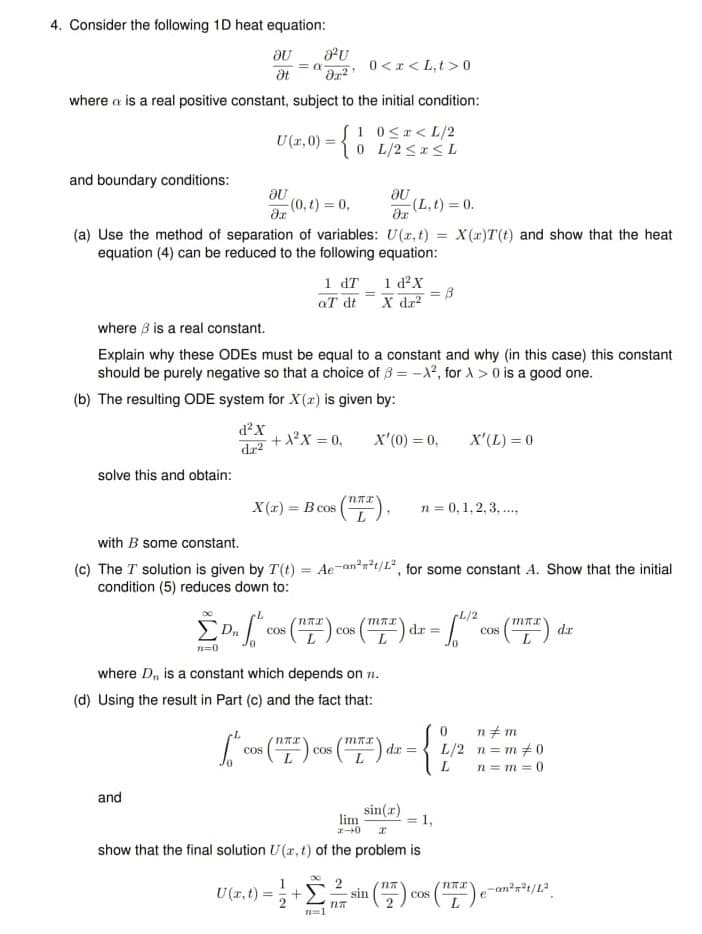4. Consider the following 1D heat equation: U = a 00 t where a is a real positive constant, subject to the initial condition: 1 0 0 is a good one. (b) The resulting ODE system for X(x) is given by: d²X +X²X = 0, dr? X'(0) = 0, X'(L) = 0 solve this and obtain: X (r) = B cos n = 0,1,2,3, . %3D with B some constant. (c) The T solution is given by T(t) = Ae-ana*t/L*, for some constant A. Show that the initial condition (5) reduces down to: %3D L/2 COS Cos COS dr n=0 where D, is a constant which depends on n.
4. Consider the following 1D heat equation: U = a 00 t where a is a real positive constant, subject to the initial condition: 1 0 0 is a good one. (b) The resulting ODE system for X(x) is given by: d²X +X²X = 0, dr? X'(0) = 0, X'(L) = 0 solve this and obtain: X (r) = B cos n = 0,1,2,3, . %3D with B some constant. (c) The T solution is given by T(t) = Ae-ana*t/L*, for some constant A. Show that the initial condition (5) reduces down to: %3D L/2 COS Cos COS dr n=0 where D, is a constant which depends on n.
Advanced Engineering Mathematics
10th Edition
ISBN:9780470458365
Author:Erwin Kreyszig
Publisher:Erwin Kreyszig
Chapter2: Second-order Linear Odes
Section: Chapter Questions
Problem 1RQ
Related questions
Question
part C and D solutio needed urgenty

Transcribed Image Text:4. Consider the following 1D heat equation:
= a
0<r < L,t > 0
at
where a is a real positive constant, subject to the initial condition:
1 0<r< L/2
U(1,0) = {0 L/2 <SL
and boundary conditions:
(0,t) = 0,
(L,t) = 0.
(a) Use the method of separation of variables: U(r, t) = X(x)T(t) and show that the heat
equation (4) can be reduced to the following equation:
%3D
1 dT 1 d²X
aT dt
X da?
where 3 is a real constant.
Explain why these ODES must be equal to a constant and why (in this case) this constant
should be purely negative so that a choice of 3 = -X, for A > 0 is a good one.
(b) The resulting ODE system for X(x) is given by:
d²X
+X²X = 0,
dr2
x'(0) = 0,
X'(L) = 0
solve this and obtain:
X (r) = B cos
n = 0,1, 2,3, .
%3D
with B some constant.
(c) The T solution is given by T(t) = Ae-an*a*t/L*, for some constant A. Show that the initial
condition (5) reduces down to:
L/2
COS
Cos
COS
da
n=0
where D, is a constant which depends on n.
(d) Using the result in Part (c) and the fact that:
{
n+ m
L/2 n= m+0
n = m = 0
Cos
cos
dx =
and
sin(r)
lim
1,
show that the final solution U(r, t) of the problem is
U (r,t):
sin
cos
n=1
Expert Solution
This question has been solved!
Explore an expertly crafted, step-by-step solution for a thorough understanding of key concepts.
Step by step
Solved in 3 steps with 2 images

Recommended textbooks for you

Advanced Engineering Mathematics
Advanced Math
ISBN:
9780470458365
Author:
Erwin Kreyszig
Publisher:
Wiley, John & Sons, Incorporated

Numerical Methods for Engineers
Advanced Math
ISBN:
9780073397924
Author:
Steven C. Chapra Dr., Raymond P. Canale
Publisher:
McGraw-Hill Education

Introductory Mathematics for Engineering Applicat…
Advanced Math
ISBN:
9781118141809
Author:
Nathan Klingbeil
Publisher:
WILEY

Advanced Engineering Mathematics
Advanced Math
ISBN:
9780470458365
Author:
Erwin Kreyszig
Publisher:
Wiley, John & Sons, Incorporated

Numerical Methods for Engineers
Advanced Math
ISBN:
9780073397924
Author:
Steven C. Chapra Dr., Raymond P. Canale
Publisher:
McGraw-Hill Education

Introductory Mathematics for Engineering Applicat…
Advanced Math
ISBN:
9781118141809
Author:
Nathan Klingbeil
Publisher:
WILEY

Mathematics For Machine Technology
Advanced Math
ISBN:
9781337798310
Author:
Peterson, John.
Publisher:
Cengage Learning,

